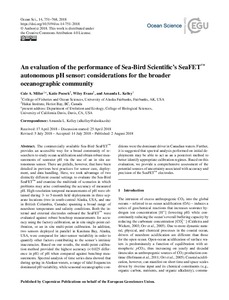An evaluation of the performance of Sea-Bird Scientific’s SeaFET™ autonomous pH sensor: considerations for the broader oceanographic community.

View/
Average rating
votes
Date
2018Author
Miller, Cale A.
Pocock, Katie
Evans, Wiley
Kelley, Amanda L.
Metadata
Show full item recordAbstract
The commercially available Sea-Bird SeaFET™
provides an accessible way for a broad community of researchers to study ocean acidification and obtain robust measurements of seawater pH via the use of an in situ autonomous sensor. There are pitfalls, however, that have been
detailed in previous best practices for sensor care, deployment, and data handling. Here, we took advantage of two
distinctly different coastal settings to evaluate the Sea-Bird
SeaFET™ and examine the multitude of scenarios in which
problems may arise confounding the accuracy of measured
pH. High-resolution temporal measurements of pH were obtained during 3- to 5-month field deployments in three separate locations (two in south-central Alaska, USA, and one
in British Columbia, Canada) spanning a broad range of
nearshore temperature and salinity conditions. Both the internal and external electrodes onboard the SeaFET™ were
evaluated against robust benchtop measurements for accuracy using the factory calibratio.....
Journal
Ocean ScienceVolume
14Page Range
pp.751–768Document Language
enBest Practice Type
GuideCitation
Cale A. Miller, C.A.; Pocock, K.; Evans, W.and Kelley, A;L. (2018) An evaluation of the performance of Sea-Bird Scientific’s SeaFET™ autonomous pH sensor: considerations for the broader oceanographic community. Ocean Science, 14, pp.751–768. DOI: 10.5194/os-14-751-2018Collections
The following license files are associated with this item:
 Repository of community practices in Ocean Research, Applications and Data/Information Management
Repository of community practices in Ocean Research, Applications and Data/Information Management
